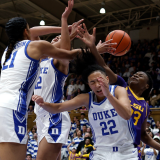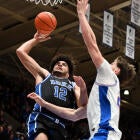Conference realignment: Five takeaways for college basketball teams moving to new leagues for 2024-2025 season
Here's who is moving where and the top storylines after final 2024-25 conference changes become official Friday

A monumental day in college athletics is on the horizon as the final conference realignment moves become official. The Pac-12 as we know it will dissolve Friday when Cal and Stanford join the ACC, Arizona, Arizona State, Colorado and Utah become members of the Big 12 and Oregon, UCLA, USC and Washington depart for the Big Ten.
SMU's move to the ACC and Oklahoma and Texas' arrival in the SEC became official in June and Friday moves mark the final realignment shifts for this academic year.
The Big 12 was the biggest player in conference realignment last season when it added BYU, Cincinnati, Houston and UCF to swell membership to 14.
The Big Ten will see its membership grow to 18 — making it the most populated conference in the sport. With big moves comes hefty travel, as all four new members will rack up airline miles when they take cross-country trips to some of the schools located on the East Coast.
Here are the five biggest takeaways on this season's college basketball's conference changes across Division I. Below that, we've got the list of all the schools moving to new leagues for the 2024-25 season.
Big 12 has strong case for best hoops conference
When the Big 12 added BYU, Cincinnati, Houston and UCF last summer, the conference had a very strong case as the best college basketball conference in the country. Even though Oklahoma and Texas are leaving in favor of the SEC, the conference is getting even stronger with the additions of Arizona, Arizona State, Colorado and Utah. Arizona is by far the best basketball brand being added to the Big 12, but there's reason to believe the other members can eventually leave a footprint.
Arizona State has reached the NCAA Tournament three times under coach Bobby Hurley, and added some interesting pieces to the roster — headlined by five-star center and former Kentucky signee Jayden Quaintance. Colorado is fresh off an appearance in the NCAA Tournament and Utah made a deep run in the NIT this past spring. BYU and Houston both made the NCAA Tournament in their first season as a member, while Cincinnati and UCF finished tied for third-worst in the conference.

Big Ten swells to unprecedented membership
The Big Ten is strictly adding this realignment cycle. When Oregon, UCLA, USC and Washington officially join the conference, the league will swell to 18 members — the most among all Division l conferences. With big membership comes hefty travel plans, as the four West Coast additions to the conference will have to travel a lot more than they're used to. For example, USC will play Illinois, Indiana, Maryland, Nebraska, Northwestern, Purdue and Rutgers, which racks up to over 13,000 miles one-way.
"It's going to be challenging, not just a little bit, but a lot," USC coach Eric Musselman told CBS Sports. "For all sports, probably football a little bit less because just like the NFL, their travel is not quite as difficult. ... Quite frankly, UCLA, Washington, USC and Oregon, we're all probably lose a game or two based solely on travel. It's just how it is in the NBA."
NBA-like travel requirements could be an advantage for a team like USC, which is coached by someone with ample experience with the grueling travel that comes with playing at the highest level. UCLA is the biggest college basketball brand joining the Big Ten, and all four additions should give the conference a larger footprint out west — which they have never had before.
How will Oklahoma and Texas fare in the SEC?
For the first time in over a decade, the SEC expanded. It's been over three years since Texas and Oklahoma announced their intentions to leave the Big 12 for the SEC and the move officially came to fruition earlier this month. On the football side, it's obvious to see how Texas and Oklahoma fit into the conference, but what about the basketball side?
For starters, Texas is in a position to compete immediately in the SEC. Under Rodney Terry, the Longhorns reached the Elite Eight (under an interim tag) and guided the program back to the NCAA Tournament in his first full season in charge of the program. The Longhorns added Tramon Mark (Arkansas), Jordan Pope (Oregon State) and Julian Larry and Jayson Kent (Indiana State) in addition to five-star guard Tre Johnson — the No. 6 overall player in the 2024 recruiting cycle by 247Sports.
As for Oklahoma, it could be a tough transition to the SEC. The Sooners have missed the NCAA Tournament in three consecutive seasons under coach Porter Moser, and it's tracking that the drought could get extended. Oklahoma added Mohamed Wague (Alabama) and Kobe Elvis (Dayton) via the transfer portal and landed four-star guard Jeremiah Fears late in the recruiting cycle.
Cal, Stanford should get ready to rack up airline miles
Cal and Stanford are in a similar spot as their former Pac-12 foes Oregon, UCLA, USC and Washington. Cal will face Clemson, Duke, Georgia Tech, Louisville, North Carolina, Notre Dame, and Pittsburgh on the road and Stanford, SMU, and NC State in a home-and-home. Stanford has Clemson, Duke, Georgia Tech, Louisville, North Carolina, Notre Dame and Pittsburgh on the road and a home-and-home with Cal, SMU and Wake Forest.
Cal hasn't reached the NCAA Tournament since 2016, while Stanford is 12 years removed from its last appearance in the Big Dance. Stanford hired Kyle Smith away from his post at Washington State to replace Jerod Haase, while Mark Madsen will enter his second season at the helm of the Cal program.
Historically, Cal and Stanford don't offer a ton of traditional basketball to the ACC. The same can be said about SMU, a program that's reached the NCAA Tournament twice in the last 30 years.
WCC gets better because of the Pac-12's demise
The WCC has been a two-team race at the top (between Saint Mary's and Gonzaga) for about the last decade. Adding Oregon State and Washington State as affilliate members for the next two seasons won't make the conference elite, but it should add more competition at the top. Washington State reached the NCAA Tournament for the first time in over a decade, and Oregon State is less than three years removed from reaching the Elite Eight.
Oregon State and Washington State aligning with the WCC for at least the next two seasons isn't a permanent solution, but it should make late-night WCC basketball much more fun to watch when all other games are finished each evening for the time being.
2024-25 college basketball conference changes
| School | Former conference | New conference |
| Arizona | Pac-12 | Big 12 |
| Arizona State | Pac-12 | Big 12 |
| California | Pac-12 | ACC |
| Chicago State | Independent | NEC |
| Colorado | Pac-12 | Big 12 |
| Kennesaw State | ASUN | CUSA |
| Mercyhurst | PSAC (D–II) | NEC |
| Merrimack | NEC | MAAC |
| Oklahoma | Big 12 | SEC |
| Oregon | Pac-12 | Big Ten |
| Oregon State | Pac-12 | WCC* |
| Sacred Heart | NEC | MAAC |
| SMU | AAC | ACC |
| Stanford | Pac-12 | ACC |
| Stephen F. Austin | WAC | Southland |
| Texas | Big 12 | SEC |
| UCLA | Pac-12 | Big Ten |
| USC | Pac-12 | Big Ten |
| Utah | Pac-12 | Big 12 |
| UTRGV | WAC | Southland |
| Washington | Pac-12 | Big Ten |
| Washington State | Pac-12 | WCC* |
| West Georgia | Gulf South (D–II) | ASUN |


















